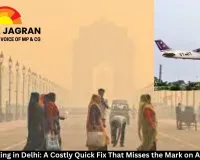India's Air Pollution: A Silent War on Our People and Future
Digital Desk

India is suffocating under a toxic blanket of air pollution that claims two million lives every year a crisis that has escalated into a full-blown assault on public health, economic vitality, and national security.
The State of Global Air 2025 report reveals a devastating 43% surge in pollution-related deaths since 2000, transforming what was once an environmental concern into an existential threat that demands immediate and decisive action.
The Human Cost: A Public Health Catastrophe
The numbers are staggering and heartbreaking. Nearly 89% of air pollution deaths in India are now linked to non-communicable diseases including heart disease, lung cancer, diabetes, and dementia.
Air pollution contributes to approximately 70% of chronic obstructive pulmonary disease (COPD) deaths, one in three lung cancer deaths, more than one in four heart disease deaths, and nearly one in five diabetes deaths. India's air pollution mortality rate stands at 186 deaths per 100,000 people more than ten times the rate in high-income countries.
What makes this crisis particularly insidious is emerging evidence linking fine particulate matter (PM2.5) exposure to brain damage and accelerated cognitive decline.
Globally, 626,000 dementia deaths in 2023 were tied to air pollution, representing 29% of all dementia-related deaths worldwide. In India, where the entire population of 1.4 billion people lives in areas exceeding WHO air quality guidelines, every breath potentially damages not just lungs but also cognitive function and mental health.
States like Uttar Pradesh, Maharashtra, Rajasthan, Bihar, and West Bengal each recorded over 100,000 deaths in 2023 alone. The Lancet Countdown report estimates that air pollution caused approximately 1.72 million deaths in India during 2022, representing a 38% increase since 2010. This silent killer operates with devastating efficiency, cutting short productive lives and leaving families shattered.
Economic Devastation: The Hidden Costs
Beyond the incalculable human suffering, air pollution is systematically destroying India's economic prospects. The crisis cost the Indian economy an estimated $95 billion in 2019—approximately 3% of the nation's GDP. The economic toll of premature deaths from outdoor air pollution reached $339.4 billion in 2022, equivalent to 9.5% of India's GDP.
Delhi alone suffered a staggering economic loss of $5.6 billion in 2019, representing 6% of the capital's GDP—exceeding the combined losses of Mumbai, Bengaluru, and Chennai.
Productivity losses manifest across multiple dimensions: India could have gained 1.3 billion working days and $6 billion in business revenue by curbing pollution-induced absenteeism in 2019. The IT sector alone loses $1.3 billion annually to pollution-induced productivity decline.
Research from Indian call centers reveals that worker productivity drops by 11.8% with increased PM2.5 concentrations, 10.8% with rising carbon monoxide levels, and 6% with elevated ozone exposure.
When air quality deteriorates, consumer spending falls by 1.3%, costing businesses $22 billion annually. Delhi experienced a 8-10% decrease in productivity on high-pollution days, while Mumbai's Linking Road market area witnessed a 5% decline in consumer footfall during polluted winter months.
The workforce crisis extends beyond immediate productivity losses. Air pollution translates to a loss of 419 labour hours per person annually a 124% increase compared to the 1990s resulting in estimated income losses of $194 billion.
This hemorrhaging of human capital threatens India's demographic dividend and competitive advantage in the global economy.





.jpg)

.jpg)

.jpg)

